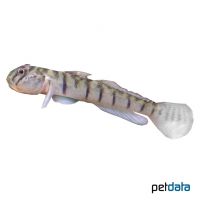Candy Cane Goby (Awaous flavus)
| Candy Cane Goby Awaous flavus | |
|---|---|
| Name | Candy Cane Goby |
| Name Lat. | Awaous flavus |
| Synonym | Gobius flavus |
| Family | Gobies |
| Family lat. | Gobiidae |
| Order | Gobies |
| Order lat. | Gobiiformes |
| Origin | South America |
| Habitat | Estuaries, rivers, streams |
| Diet | Omnivore |
| pH | 7.5-8.5 |
| Behavior | Peaceful |
| Keeping | Pair, harem |
| Care Level | Experts only |
| Reproduction | Substrate spawner |
| Breeding | None reported |
| Life Span | 5-8 years |
| Protection | No |
| Metric Units | |
| Size | 8-10 cm |
| Temperature | 25-27 °C |
| Hardness | 10-30 °dH |
| Aquarium | ~ 200 l |
| US Units | |
| Size | 3"-4" |
| Temperature | 77-81 °F |
| Hardness | 178-534 ppm |
| Aquarium | ~ 50 gal |
Distribution and habitat
Butterfly gobies are widely distributed from Colombia to the mouth of the Amazon River in Brazil. They live in oxygen-rich small rivers and streams with muddy soft bottoms that flow directly into the Atlantic Ocean. There they like to stay in the current between stones and roots.
Maintenance
The aquarium should have partly dense planting and be structured with round river pebbles, flat stones, roots and caves. A graveable substrate of sand or a fine-grained round gravel that can be covered with some foliage (sea almond tree, oak) and oxygen-rich, slightly alkaline water with a moderate to strong current is ideal
No ammonia, ammonium and nitrite should be detectable, and the nitrate value should not exceed 100 mg/l. To ensure the water quality and oxygen content, a filter and heater adapted to the aquarium size is required, as well as lighting for the species-appropriate day-night rhythm of the animals.
Diet
They chew through the substrate in search of small organisms and plant remains (detritus). The food supply consists of live or frozen cyclops, daphnia, bosmids, artemia, red mosquito larvae, etc., supplemented with high-quality dry food (granules, tablets) with vegetable components (spirulina), which is well accepted after habituation.
Only feed as much as is eaten immediately (in a maximum of 10 minutes). A regular and varied diet promotes health and increases resistance.
Behaviour and compatibility
It is recommended to keep them in pairs or in a harem, a male with several females. Males occupy small territories, which they defend against conspecifics and other bottom fish. Keeping several males is only recommended in a much larger, richly structured tank. Socialization with free swimming fish, such as tetras or viviparous fish is well possible.
Basically, only compatible fish species with similar demands on water condition and water temperature may be socialized.
Sex dimorphism
The larger and more colorful males have a wider mouth and the rays of their dorsal fin are distinctly elongated. With some experience, the sexes can be distinguished by their genital papilla, which is pointed in the male and blunt in the female.
Reproduction and breeding
There are no known reports of successful breeding in the aquarium, although egg laying does occur. The female lays thousands of tiny eggs in a cave or crevice, which are guarded by the male. After about 13 hours, the larvae hatch and their yolk sac is depleted after a few days. In nature, they must have reached the sea with the current during this time to find more food. After the larvae have completed their pelagic development in the sea, the young fish swim back upstream in the streams and small rivers.
Important
In case of danger, they burrow into the substrate
For permanent keeping, a small addition (approx. 1 tablespoon per 10 l water) of sea salt (mineral salt) from the pet shop is recommended for water hardening. If the water is sufficiently hard and alkaline, the addition of salt is not necessary.
The well-being of the fish should be checked regularly. The temperature should be checked daily, the pH value, hardness and nitrate value at least every 14 days. A regular partial water change is recommended, even if the pollutant load has not yet reached the upper limit. Sudden changes in water quality should be avoided. Newly introduced fish must be accustomed slowly to the water in the aquarium
Further literature can be found in your pet store.
References
Text: Werner Winter; Image: petdata
Source: BMELV (1998): Tierschutzgutachten - Haltung von Zierfischen (Süßwasser); RIEHL & BAENSCH (2004): Aquarien Atlas Bd. 3, Mergus Verlag; ENGELMANN (2005): Zootierhaltung - Tiere in menschlicher Obhut: Fische, Verlag Harri Deutsch
- Gemäß § 21 Abs. 5 Tierschutzgesetz idgF
